串行接口应用
单片机原理及应用第6章80C51单片机的串行口

单片机原理及应用第6章80C51单片机的串行口80C51单片机是一种基于哈佛架构的8位单片机,具有强大的串行口功能。
串行口是一种通信接口,可以通过单根线传输数据。
本章将介绍80C51单片机的串行口原理及其应用。
一、80C51单片机的串行口原理80C51单片机的串行口包含两个寄存器,分别是SBUF(串行缓冲器)和SCON(串行控制寄存器)。
SBUF寄存器用来存储待发送或接收到的数据,SCON寄存器用来配置和控制串行口的工作模式。
80C51单片机的串行口有两种工作模式:串行异步通信模式和串行同步通信模式。
1.串行异步通信模式串行异步通信是指通信双方的时钟频率不同步,通信的数据按照字符为单位进行传输,字符之间有起始位、数据位、校验位和停止位组成。
80C51单片机的串行口支持标准的RS-232通信协议和非标准通信协议。
在串行异步通信模式下,SCON寄存器需要配置为相应的工作模式。
首先,需要选择串行口的工作模式。
80C51单片机支持第9位,即扩展模式,可以用来检测通信错误。
其次,需要设置波特率。
波特率是指数据每秒传输的位数,用波特率发生器(Baud Rate Generator,BRGR)来控制。
然后,需要设置起始位、数据位和停止位的配置,包括数据长度(5位、6位、7位或8位)、停止位的个数(1位或2位)。
在发送数据时,将待发送的数据通过MOV指令传送到SBUF寄存器,单片机会自动将数据发送出去。
在接收数据时,需要检测RI(接收中断)标志位,如果RI为1,表示接收到数据,可以通过MOV指令将接收到的数据读取到用户定义的变量中。
2.串行同步通信模式串行同步通信是指通信双方的时钟频率同步,在数据传输时需要时钟信号同步。
80C51单片机的串行同步通信支持SPI(串行外设接口)和I2C(串行总线接口)两种协议。
在串行同步通信模式下,SCON寄存器需要配置为相应的工作模式。
首先,需要选择串行口的工作模式。
80C51单片机支持主从模式,可以作为主设备发送数据,也可以作为从设备接收数据。
简述usb接口的应用特点
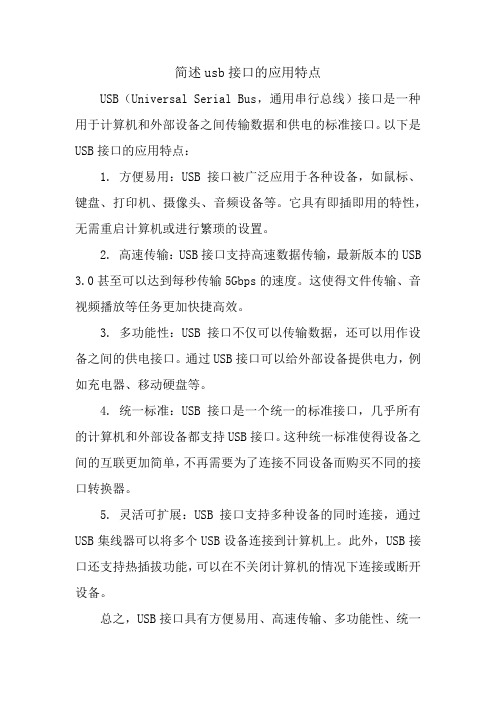
简述usb接口的应用特点
USB(Universal Serial Bus,通用串行总线)接口是一种用于计算机和外部设备之间传输数据和供电的标准接口。
以下是USB接口的应用特点:
1. 方便易用:USB接口被广泛应用于各种设备,如鼠标、键盘、打印机、摄像头、音频设备等。
它具有即插即用的特性,无需重启计算机或进行繁琐的设置。
2. 高速传输:USB接口支持高速数据传输,最新版本的USB
3.0甚至可以达到每秒传输5Gbps的速度。
这使得文件传输、音视频播放等任务更加快捷高效。
3. 多功能性:USB接口不仅可以传输数据,还可以用作设备之间的供电接口。
通过USB接口可以给外部设备提供电力,例如充电器、移动硬盘等。
4. 统一标准:USB接口是一个统一的标准接口,几乎所有的计算机和外部设备都支持USB接口。
这种统一标准使得设备之间的互联更加简单,不再需要为了连接不同设备而购买不同的接口转换器。
5. 灵活可扩展:USB接口支持多种设备的同时连接,通过USB集线器可以将多个USB设备连接到计算机上。
此外,USB接口还支持热插拔功能,可以在不关闭计算机的情况下连接或断开设备。
总之,USB接口具有方便易用、高速传输、多功能性、统一
标准和灵活可扩展等特点,使得它成为计算机和外部设备之间最常见和广泛应用的接口之一。
串行通信接口及总线标准

RS-4
定义
RS-485是一种改进的串行 通信接口标准,由EIA制定。
特点
采用差分信号传输方式, 具有多站能力、高抗干扰 能力和长距离传输能力。
应用
广泛应用于工业自动化、 楼宇自动化和智能家居等 领域。
SPI
定义
应用
SPI是一种同步串行通信协议,由摩托 罗拉公司制定。
常用于微控制器和外围设备之间的通 信。
感谢观看
详细描述
在工业自动化控制系统中,各种设备如传感器、执行器、控制器等需要实时地进行数据交换和通信。 串行通信接口能够提供稳定、可靠的连接,使得设备间能够高效地传输数据,实现自动化控制和监测 。这有助于提高生产效率、降低成本、减少故障发生率。
智能家居系统
总结词
串行通信接口在智能家居系统中发挥关键作用,能够实现家庭设备的互联互通,提升家居生活的便利性和舒适度。
VS
详细描述
物联网设备间需要进行大量的数据交换和 通信,以实现设备的远程监控和管理。串 行通信接口能够提供高效、可靠的数据传 输服务,使得设备间能够稳定地进行通信 。这有助于促进物联网的发展和应用,提 高设备的可维护性和可管理性,降低运营 成本。
汽车电子系统
总结词
串行通信接口在汽车电子系统中具有重要价 值,能够实现汽车各系统间的信息共享和协 同工作,提高汽车的安全性和可靠性。
数据传输速率较慢。
03
02
特点
04
数据传输距离较远。
数据传输线少,成本低。
05
06
适用于不同设备之间的通信。
串行通信接口的重要性
01
02
03
04
实现设备之间的数据交换和通 信。
简化电路设计,降低成本。
常用通讯接口介绍及应用
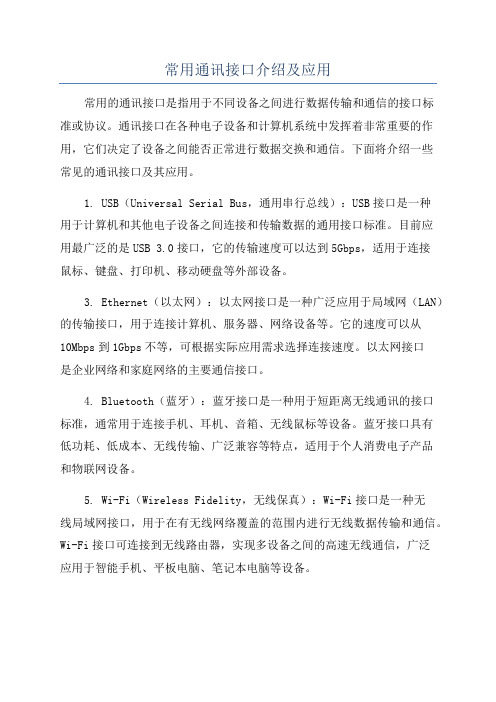
常用通讯接口介绍及应用常用的通讯接口是指用于不同设备之间进行数据传输和通信的接口标准或协议。
通讯接口在各种电子设备和计算机系统中发挥着非常重要的作用,它们决定了设备之间能否正常进行数据交换和通信。
下面将介绍一些常见的通讯接口及其应用。
1. USB(Universal Serial Bus,通用串行总线):USB接口是一种用于计算机和其他电子设备之间连接和传输数据的通用接口标准。
目前应用最广泛的是USB 3.0接口,它的传输速度可以达到5Gbps,适用于连接鼠标、键盘、打印机、移动硬盘等外部设备。
3. Ethernet(以太网):以太网接口是一种广泛应用于局域网(LAN)的传输接口,用于连接计算机、服务器、网络设备等。
它的速度可以从10Mbps到1Gbps不等,可根据实际应用需求选择连接速度。
以太网接口是企业网络和家庭网络的主要通信接口。
4. Bluetooth(蓝牙):蓝牙接口是一种用于短距离无线通讯的接口标准,通常用于连接手机、耳机、音箱、无线鼠标等设备。
蓝牙接口具有低功耗、低成本、无线传输、广泛兼容等特点,适用于个人消费电子产品和物联网设备。
5. Wi-Fi(Wireless Fidelity,无线保真):Wi-Fi接口是一种无线局域网接口,用于在有无线网络覆盖的范围内进行无线数据传输和通信。
Wi-Fi接口可连接到无线路由器,实现多设备之间的高速无线通信,广泛应用于智能手机、平板电脑、笔记本电脑等设备。
6. SATA(Serial ATA,串行ATA):SATA接口是一种用于连接计算机主板和存储设备(如硬盘、SSD)的接口标准。
SATA接口具有高速传输、易于安装、可靠性高等特点,适用于个人电脑和服务器等设备。
除了上述介绍的通讯接口,还有很多其他常用的通讯接口,如RS-232、RS-485、CAN(Controller Area Network,控制器局域网)、I2C (Inter Integrated Circuit,串行总线)、SPI(Serial Peripheral Interface,串行外设接口)等,它们在各种电子设备和计算机系统中应用广泛。
电子系统设计中常用串行接口及其应用

电子系统设计中常用串行接口及其应用在电子系统设计中,串行接口是一种常用的通信协议,用于在多个设备之间传输数据。
与并行接口相比,串行接口只需使用一条信号线来传输数据,因此可以减少硬件复杂度、节省成本,并且具有更好的扩展性和可靠性。
下面将介绍一些常见的串行接口及其应用。
1. 串行通用总线(Serial General Purpose Interface,SGPI):SGPI是一种开放标准的串行总线接口,可以在各种应用中使用,包括计算机、通信设备、工业自动化等。
它支持高速的全双工数据传输,可以连接多个设备,并提供了可靠的错误检测和纠正机制。
SGPI还支持热插拔功能,方便设备的添加和移除。
2. 串行外设接口(Serial Peripheral Interface,SPI):SPI是一种常用的串行通信接口,常用于连接微控制器和外设设备,如存储器、传感器、显示器等。
SPI接口使用4条信号线实现全双工的数据传输:主设备输出SCLK时钟信号,从设备接收数据(MISO)、主设备发送数据(MOSI)和主设备选择从设备(SS)。
SPI接口具有高速传输、简单灵活、可靠性高等特点,适用于多种应用场景。
3. 串行高速接口(Serial Advanced Technology Attachment,SATA):SATA是一种用于连接计算机硬盘驱动器和光盘驱动器的串行接口,取代了传统的并行接口(IDE)。
SATA接口使用7条信号线进行数据传输,支持高达6 Gbps的传输速度。
SATA接口具有高速传输、抗干扰能力强、线缆长度灵活等特点,广泛应用于个人电脑、服务器等领域。
4. 通用串行总线(Universal Serial Bus,USB):USB是一种广泛应用于计算机和消费电子产品中的串行接口标准。
USB接口可以连接各种外部设备,如键盘、鼠标、打印机、摄像头等。
USB接口提供了简单易用的插拔功能,支持高速数据传输和供电能力。
USB接口还定义了各种协议和设备类别,方便不同设备的互联互通。
高级英语(考研方向) 串行口
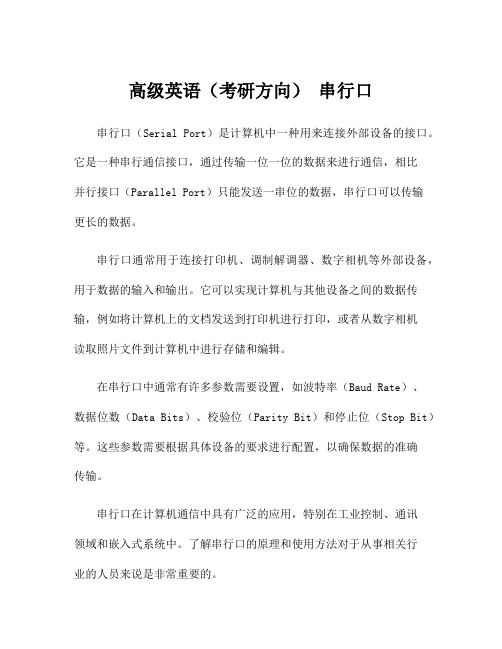
高级英语(考研方向)串行口串行口(Serial Port)是计算机中一种用来连接外部设备的接口。
它是一种串行通信接口,通过传输一位一位的数据来进行通信,相比
并行接口(Parallel Port)只能发送一串位的数据,串行口可以传输
更长的数据。
串行口通常用于连接打印机、调制解调器、数字相机等外部设备,用于数据的输入和输出。
它可以实现计算机与其他设备之间的数据传输,例如将计算机上的文档发送到打印机进行打印,或者从数字相机
读取照片文件到计算机中进行存储和编辑。
在串行口中通常有许多参数需要设置,如波特率(Baud Rate)、
数据位数(Data Bits)、校验位(Parity Bit)和停止位(Stop Bit)等。
这些参数需要根据具体设备的要求进行配置,以确保数据的准确
传输。
串行口在计算机通信中具有广泛的应用,特别在工业控制、通讯
领域和嵌入式系统中。
了解串行口的原理和使用方法对于从事相关行
业的人员来说是非常重要的。
USB接口在单片机系统中的应用实践与优化

USB接口在单片机系统中的应用实践与优化USB(Universal Serial Bus)(通用串行总线)接口是一种用于计算机和外部设备之间进行数据传输和通信的标准接口。
在单片机系统中,USB接口的应用逐渐得到广泛应用并快速发展。
本文将介绍USB接口在单片机系统中的应用实践以及针对其优化的一些方法和技巧。
USB接口的应用实践起初主要是在个人计算机和外部设备之间进行数据传输,然而,随着单片机内部资源的不断增加和成本的不断降低,USB接口在单片机系统中的应用逐渐增多。
在实践中,USB接口在单片机系统中的应用主要体现在以下几个方面:1. 数据传输:单片机经过USB接口与外部设备进行数据传输,可以实现快速、稳定的数据传输。
例如,可以通过USB接口将单片机与电脑连接,实现数据的读取和写入,用于程序的下载、数据的采集等。
2. 外设控制:USB接口可以连接各种外部设备,如键盘、鼠标、打印机等。
通过单片机与USB接口的结合,可以实现对这些外部设备的控制。
例如,可以通过单片机控制USB接口与打印机进行数据传输,实现打印功能。
3. 通信功能:USB接口支持实时数据传输,可以方便地实现与其他设备之间的通信。
单片机可以通过USB接口与其他设备进行通信,如与传感器进行数据交互、与上位机进行通讯等。
针对USB接口在单片机系统中的应用,我们可以采取一些优化方法和技巧,以提高系统的性能和稳定性。
下面是一些常见的优化方法:1. 选用合适的USB芯片:不同的USB芯片有不同的性能和功能特点,选用合适的USB芯片对系统的性能和稳定性有着重要的影响。
在选择USB芯片时,需要考虑芯片的数据传输速度、功耗和支持的USB协议等因素。
2. 合理设计电路:USB接口涉及到电路设计,合理的电路设计可以提高系统的抗干扰能力和稳定性。
例如,可以采用差分线传输方式来减小传输的干扰和噪声。
3. 优化软件设计:软件部分也是需要优化的关键点。
通过合理的软件设计,可以提高系统的性能。
简述串行接口的工作原理以及串行接口的优缺点

串行接口是一种数字接口,用于在计算机系统中传输数字信号或者数据。
串行接口通过一根线依次传输每个位的数据,相比并行接口,串行接口只需要一根线就可以进行数据传输,因此在一些场景中可以节省成本和空间。
本文将首先简述串行接口的工作原理,然后分别对串行接口的优点和缺点进行详细介绍。
一、串行接口的工作原理1. 数据传输串行接口通过一个个数据位的顺序传送数据,每个数据位通过一根线进行传输。
在传输时,数据被分割成一个个数据包,每个数据包由起始位、数据位、校验位和停止位组成。
这些数据包按照一定的规则经过线路传输,接收端再将这些数据包组装还原成原始数据。
而整个过程中,数据包的传输是依赖于时钟脉冲信号的。
2. 时钟信号为了确保接收端能够正确地接收和理解发送端的数据,串行接口需要一个时钟信号来进行数据的同步。
时钟信号在数据传输的过程中充当了一个重要的角色,确保发送端的数据能够被准确地读取和复原。
3. 带宽利用串行接口能够更好地利用带宽,因为它只需要一根线来进行数据传输。
在一些对带宽有限制的环境下,串行接口可以更好地满足需求。
二、串行接口的优缺点串行接口作为一种常见的数字接口,在许多设备中被广泛使用。
其优缺点如下:优点:1. 使用简单串行接口只需要一根线进行数据传输,在设计和使用上相对简单。
这对于一些资源有限的情况下尤为重要,比如在一些嵌入式系统中,串行接口能够更好地满足需要。
2. 抗干扰能力强因为串行接口只需要一根线进行数据传输,相比并行接口,串行接口在传输过程中对于干扰的抵抗能力更强。
这使得串行接口能够更好地适用于电磁干扰严重的环境。
3. 长距离传输串行接口可以支持较长的传输距离,这对于一些需要进行长距离数据传输的场景非常重要。
缺点:1. 传输速率低由于串行接口是逐位传输数据的,因此在相同条件下,它的传输速率往往比并行接口要低。
这意味着在需要进行高速数据传输的场景下,串行接口可能无法满足需求。
2. 数据传输效率低串行接口在数据传输的过程中需要进行数据包的分割和再组装,这会导致数据传输的效率较低,尤其在大批量数据传输的情形下。
单片机串行口及应用特百度
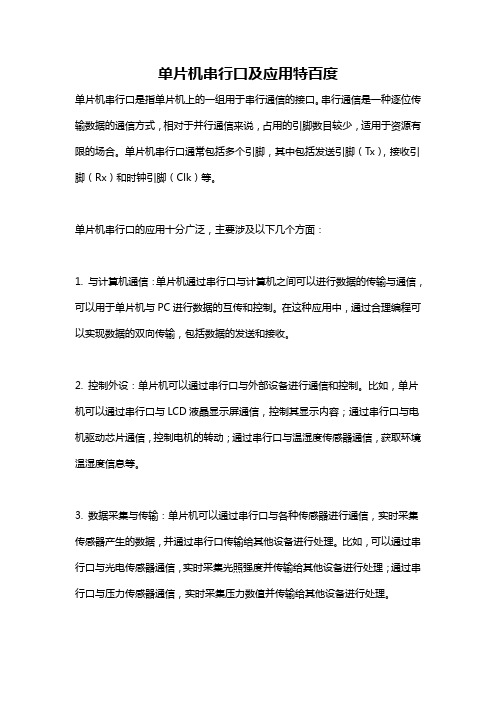
单片机串行口及应用特百度单片机串行口是指单片机上的一组用于串行通信的接口。
串行通信是一种逐位传输数据的通信方式,相对于并行通信来说,占用的引脚数目较少,适用于资源有限的场合。
单片机串行口通常包括多个引脚,其中包括发送引脚(Tx),接收引脚(Rx)和时钟引脚(Clk)等。
单片机串行口的应用十分广泛,主要涉及以下几个方面:1. 与计算机通信:单片机通过串行口与计算机之间可以进行数据的传输与通信,可以用于单片机与PC进行数据的互传和控制。
在这种应用中,通过合理编程可以实现数据的双向传输,包括数据的发送和接收。
2. 控制外设:单片机可以通过串行口与外部设备进行通信和控制。
比如,单片机可以通过串行口与LCD液晶显示屏通信,控制其显示内容;通过串行口与电机驱动芯片通信,控制电机的转动;通过串行口与温湿度传感器通信,获取环境温湿度信息等。
3. 数据采集与传输:单片机可以通过串行口与各种传感器进行通信,实时采集传感器产生的数据,并通过串行口传输给其他设备进行处理。
比如,可以通过串行口与光电传感器通信,实时采集光照强度并传输给其他设备进行处理;通过串行口与压力传感器通信,实时采集压力数值并传输给其他设备进行处理。
4. 远程控制:单片机可以通过串行口与远程设备进行通信,实现对远程设备的控制。
比如,通过串行口与无线模块通信,实现对远程设备的远程开关控制;通过串行口与蓝牙模块通信,实现对蓝牙设备的远程控制等。
需要注意的是,由于单片机串行口的通信速率相对较低,一般只适合低速数据传输,对于高速数据传输,通常需要使用其他接口,如USB、以太网等。
单片机串行口在物联网、智能家居、工业控制、嵌入式系统等领域有着广泛的应用。
通过串行口的使用,可以实现信息的传输、设备的控制和数据的采集,提高系统的灵活性和可控性。
同时,单片机串行口的应用也需要深入了解串行通信的原理和相关编程知识,以保证通信的稳定和可靠性。
嵌入式系统中常见的通信接口介绍与实践
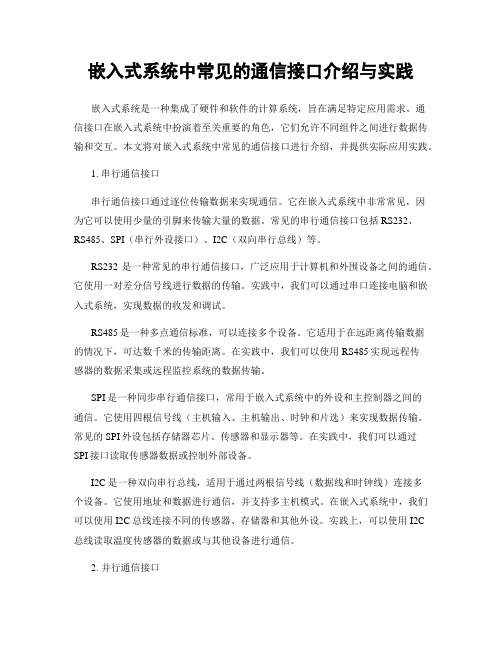
嵌入式系统中常见的通信接口介绍与实践嵌入式系统是一种集成了硬件和软件的计算系统,旨在满足特定应用需求。
通信接口在嵌入式系统中扮演着至关重要的角色,它们允许不同组件之间进行数据传输和交互。
本文将对嵌入式系统中常见的通信接口进行介绍,并提供实际应用实践。
1. 串行通信接口串行通信接口通过逐位传输数据来实现通信。
它在嵌入式系统中非常常见,因为它可以使用少量的引脚来传输大量的数据。
常见的串行通信接口包括RS232、RS485、SPI(串行外设接口)、I2C(双向串行总线)等。
RS232是一种常见的串行通信接口,广泛应用于计算机和外围设备之间的通信。
它使用一对差分信号线进行数据的传输。
实践中,我们可以通过串口连接电脑和嵌入式系统,实现数据的收发和调试。
RS485是一种多点通信标准,可以连接多个设备。
它适用于在远距离传输数据的情况下,可达数千米的传输距离。
在实践中,我们可以使用RS485实现远程传感器的数据采集或远程监控系统的数据传输。
SPI是一种同步串行通信接口,常用于嵌入式系统中的外设和主控制器之间的通信。
它使用四根信号线(主机输入、主机输出、时钟和片选)来实现数据传输。
常见的SPI外设包括存储器芯片、传感器和显示器等。
在实践中,我们可以通过SPI接口读取传感器数据或控制外部设备。
I2C是一种双向串行总线,适用于通过两根信号线(数据线和时钟线)连接多个设备。
它使用地址和数据进行通信,并支持多主机模式。
在嵌入式系统中,我们可以使用I2C总线连接不同的传感器、存储器和其他外设。
实践上,可以使用I2C总线读取温度传感器的数据或与其他设备进行通信。
2. 并行通信接口并行通信接口可以同时传输多个位的数据,它们可以提供更高的传输速率,但需要更多的引脚。
常见的并行通信接口包括ATA(并行ATA)、PCI(周边组件互连)、PCIe(PCI Express)等。
ATA是一种常见的并行通信接口,用于连接存储设备(例如硬盘驱动器)和主机系统。
串行接口与并行接口

为了满足各种设备互连的需求,串行接口技术也在不断标准化。例如,USB-C接口标准的出现,使得设备之间的 连接更加方便、可靠。
并行接口的发展趋势
高速化
随着数据传输速率的不断提高,并行接口技术也在不断向高速化方向发展。例如,PCIe 4.0、PCIe 5.0等接口标准都大大提高了数据传输速率。
集成化
串行接口
数据一位一位地顺序传送,每一位数据占据一个固定的时间长度,速度相对较 慢。
并行接口
数据多位同时传送,数据传输速度较快,但需要多条数据线同时传输。
传输距离比较
串行接口
由于数据一位一位地传送,信号线数量较少,因此适合长距离传输。
并行接口
由于需要多位数据线同时传输,信号线数量较多,因此适合短距离传输。
未来串行接口与并行接口可能会更加 智能化,可以根据设备的需求自动调 整数据传输速率和连接方式。
05
串行接口与并行接口的 实际应用案例
串行接口的实际应用案例
要点一
串行接口在打印机中的应用
打印机通过串行接口与计算机连接,实现数据的传输和控 制。
要点二
串行接口在摄像头中的应用
摄像头通过串行接口与计算机连接,实现视频信号的传输 和控制。
之间的通信。
数据采集与监控
在工业控制、智能家居等领域,串 行接口常用于连接传感器、执行器 等设备,实现数据的采集和监控。
嵌入式系统
在嵌入式系统中,由于硬件资源有 限,串行接口常常被用来进行数据 通信和控制。
02
并行接口介绍
定义与特点
定义
并行接口是一种数据传输方式,通过多个数据线同速数据传输
并行接口适用于需要高速 数据传输的场景,如打印 机、扫描仪等外设。
单片机中常见的接口类型及其功能介绍
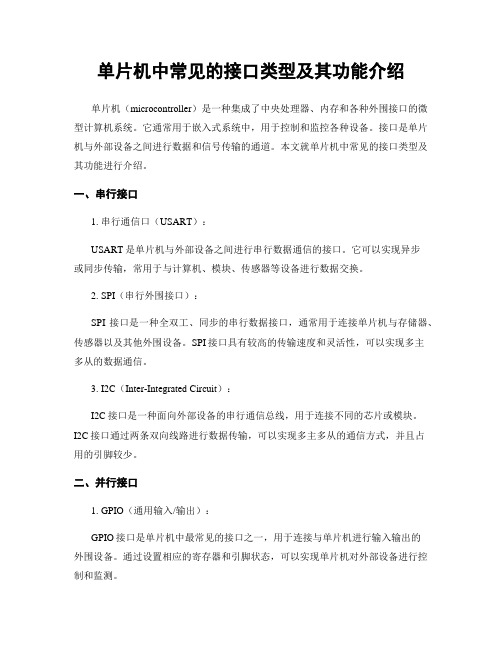
单片机中常见的接口类型及其功能介绍单片机(microcontroller)是一种集成了中央处理器、内存和各种外围接口的微型计算机系统。
它通常用于嵌入式系统中,用于控制和监控各种设备。
接口是单片机与外部设备之间进行数据和信号传输的通道。
本文就单片机中常见的接口类型及其功能进行介绍。
一、串行接口1. 串行通信口(USART):USART是单片机与外部设备之间进行串行数据通信的接口。
它可以实现异步或同步传输,常用于与计算机、模块、传感器等设备进行数据交换。
2. SPI(串行外围接口):SPI接口是一种全双工、同步的串行数据接口,通常用于连接单片机与存储器、传感器以及其他外围设备。
SPI接口具有较高的传输速度和灵活性,可以实现多主多从的数据通信。
3. I2C(Inter-Integrated Circuit):I2C接口是一种面向外部设备的串行通信总线,用于连接不同的芯片或模块。
I2C接口通过两条双向线路进行数据传输,可以实现多主多从的通信方式,并且占用的引脚较少。
二、并行接口1. GPIO(通用输入/输出):GPIO接口是单片机中最常见的接口之一,用于连接与单片机进行输入输出的外围设备。
通过设置相应的寄存器和引脚状态,可以实现单片机对外部设备进行控制和监测。
2. ADC(模数转换器):ADC接口用于将模拟信号转换为数字信号,常用于单片机中对模拟信号的采集和处理。
通过ADC接口,单片机可以将外部传感器等模拟信号转化为数字信号,便于处理和分析。
3. DAC(数模转换器):DAC接口用于将数字信号转换为模拟信号。
通过DAC接口,单片机可以控制外部设备的模拟量输出,如音频输出、电压控制等。
三、特殊接口1. PWM(脉冲宽度调制):PWM接口用于产生特定占空比的脉冲信号。
通过调节脉冲的宽度和周期,可以控制外部设备的电平、亮度、速度等。
PWM接口常用于控制电机、LED灯、舵机等设备。
2. I2S(串行音频接口):I2S接口用于在单片机和音频设备之间进行数字音频数据传输。
UART串行扩展接口应用实例

UART串行扩展接口应用实例UART(Universal Asynchronous Receiver/Transmitter):通用异步收发器,既能同步又能异步通信的硬件电路称为UART。
UART是用于掌握计算机与串行设备的芯片,它供应了RS-232C数据终端设备接口,这样计算机就可以和调制解调器或其他使用RS-232C接口的串行设备通信了。
80C51的串行通信口是一个功能强大的通信口,而且是相当好用的通信口。
用于显示驱动电路特别合适,下面我们就依据这种需要用两个串行通信口线加上两根一般I/O口线,设计一个4位LED显示电路。
当然只要再加上两根I/O口线即可轻易实现8位LED显示电路。
例1:如图1所示的电原理图,利用74LS164串行输入并行输出芯片作一个简洁的电子钟,要求四个数码管显示时钟;其中LED1显示小时的十位,LED2显示小时的个位,LED3显示分钟的十位,LED4显示分钟的个位。
图1 串行动态LED扫描电路解:采纳单片机的串行口输出字形码,用74LS164和74LS139作为扩展芯片。
74LS164的功能是将80C51串行通信口输出的串行数据译码并在其并口线上输出,从而驱动LED 数码管。
74LS139是一个双2-4线译码器,它将单片机输出的地址信号译码后动态驱动相应的LED。
因74LS139电流驱动力量较小,故用末级驱动三极管9013作为地址驱动。
将4只LED的字段位都连在一起,它们的公共端则由74LS139分时选通,这样任何一个时刻,都只有一位LED在点亮,也即动态扫描显示方式,其优点使用串行口进行LED通信程序编写相当简洁,用户只需将需显示的数据直接送串口发送缓冲器,等待串行发送完毕标志位即可。
参考程序如下:上面是一个简洁的动态扫描程序,假如再利用上第6章的定时器就可做成一个完整的电子钟,四个数码管显示为00:00这种形式。
在本例中冒号就不显示出来了,分别用20H、21H 、22H、23H地址在放时间的时钟的十位、时钟的个位、分钟的十位、分钟的个位。
232接口和485接口
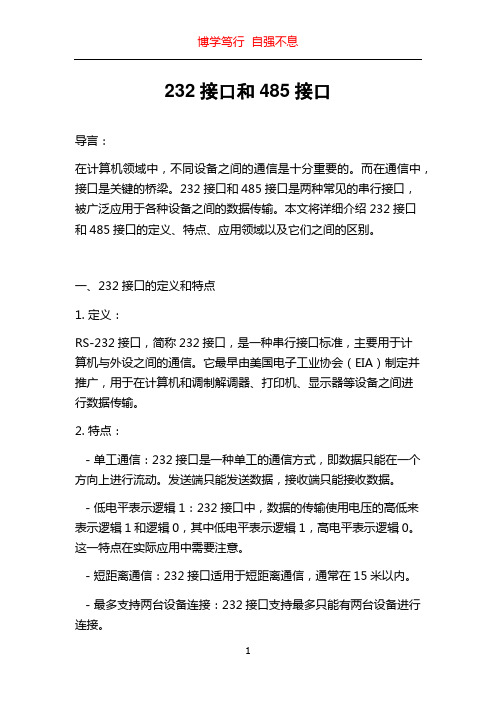
232接口和485接口导言:在计算机领域中,不同设备之间的通信是十分重要的。
而在通信中,接口是关键的桥梁。
232接口和485接口是两种常见的串行接口,被广泛应用于各种设备之间的数据传输。
本文将详细介绍232接口和485接口的定义、特点、应用领域以及它们之间的区别。
一、232接口的定义和特点1. 定义:RS-232接口,简称232接口,是一种串行接口标准,主要用于计算机与外设之间的通信。
它最早由美国电子工业协会(EIA)制定并推广,用于在计算机和调制解调器、打印机、显示器等设备之间进行数据传输。
2. 特点:- 单工通信:232接口是一种单工的通信方式,即数据只能在一个方向上进行流动。
发送端只能发送数据,接收端只能接收数据。
- 低电平表示逻辑1:232接口中,数据的传输使用电压的高低来表示逻辑1和逻辑0,其中低电平表示逻辑1,高电平表示逻辑0。
这一特点在实际应用中需要注意。
- 短距离通信:232接口适用于短距离通信,通常在15米以内。
- 最多支持两台设备连接:232接口支持最多只能有两台设备进行连接。
二、485接口的定义和特点1. 定义:RS-485接口,简称485接口,也是一种串行接口标准,与232接口类似,但在数据传输的方式上有所不同。
它同样由美国电子工业协会(EIA)制定,用于在工业现场和设备之间进行长距离数据传输。
2. 特点:- 双工通信:485接口是一种双工的通信方式,即数据可以同时在两个方向上进行流动。
发送端可以发送数据,接收端也可以同时接收数据。
- 差分信号传输:485接口中,数据的传输采用差分信号传输方式,即通过一个正向信号线和一个反向信号线来表示逻辑1和逻辑0。
这种方式在长距离传输中具有较好的抗干扰能力。
- 长距离通信:485接口适用于长距离通信,通常可以支持最长达1200米的距离。
- 多设备连接:485接口支持多个设备连接,最多可达到32个。
三、232接口和485接口的应用领域1. 232接口的应用领域:- 通信设备:232接口常用于计算机与调制解调器、打印机、显示器等通信设备之间的连接,用于数据传输和通信控制。
串行应用实验报告

一、实验目的1. 理解串行通信的基本原理和常用方式。
2. 掌握串行通信接口的硬件连接和软件编程。
3. 实现两个设备之间的串行通信,验证通信的可靠性。
二、实验原理串行通信是指数据在一条线上按位顺序传输,每传输一位数据后,再传输下一位数据。
与并行通信相比,串行通信具有传输距离远、抗干扰能力强、成本较低等优点。
常用的串行通信方式有RS-232、RS-485等。
三、实验设备1. 电脑一台2. 串口通信模块(如:USB转串口模块)3. 串行通信线(如:串行线、USB线)4. 实验板(如:Arduino板)5. 相关软件(如:串口调试助手)四、实验步骤1. 硬件连接(1)将USB转串口模块连接到电脑,确保模块上的指示灯亮起,表示已正常连接。
(2)将串行通信线的一端连接到USB转串口模块的TXD、RXD、GND引脚,另一端连接到实验板的RXD、TXD、GND引脚。
2. 软件设置(1)打开串口调试助手,设置串行通信参数:- 波特率:9600- 数据位:8- 停止位:1- 校验位:无(2)将实验板上的串行通信模块(如Arduino板)连接到电脑,打开实验板上的电源。
3. 编写程序(1)编写实验板的程序,实现数据的发送和接收。
以下为Arduino板示例程序:```cpp#include <SoftwareSerial.h>SoftwareSerial mySerial(10, 11); // RX, TXvoid setup() {Serial.begin(9600);mySerial.begin(9600);}void loop() {if (mySerial.available()) {char received = mySerial.read();Serial.print("Received: ");Serial.println(received);}if (Serial.available()) {char sent = Serial.read();mySerial.print("Sent: ");mySerial.println(sent);}}```(2)将程序上传到实验板。
单片机中的USB接口技术与应用
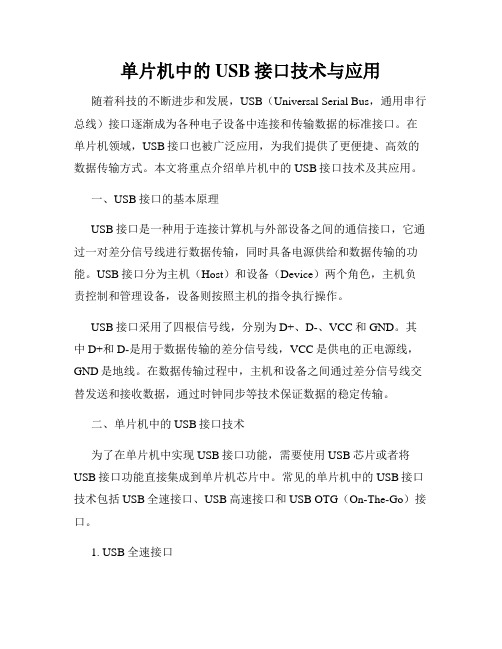
单片机中的USB接口技术与应用随着科技的不断进步和发展,USB(Universal Serial Bus,通用串行总线)接口逐渐成为各种电子设备中连接和传输数据的标准接口。
在单片机领域,USB接口也被广泛应用,为我们提供了更便捷、高效的数据传输方式。
本文将重点介绍单片机中的USB接口技术及其应用。
一、USB接口的基本原理USB接口是一种用于连接计算机与外部设备之间的通信接口,它通过一对差分信号线进行数据传输,同时具备电源供给和数据传输的功能。
USB接口分为主机(Host)和设备(Device)两个角色,主机负责控制和管理设备,设备则按照主机的指令执行操作。
USB接口采用了四根信号线,分别为D+、D-、VCC和GND。
其中D+和D-是用于数据传输的差分信号线,VCC是供电的正电源线,GND是地线。
在数据传输过程中,主机和设备之间通过差分信号线交替发送和接收数据,通过时钟同步等技术保证数据的稳定传输。
二、单片机中的USB接口技术为了在单片机中实现USB接口功能,需要使用USB芯片或者将USB接口功能直接集成到单片机芯片中。
常见的单片机中的USB接口技术包括USB全速接口、USB高速接口和USB OTG(On-The-Go)接口。
1. USB全速接口USB全速接口是目前应用最广泛的USB接口技术之一。
它可以在单片机与主机之间实现以1.5Mbps的速率进行数据传输,适用于低速率和中速率的数据交换。
USB全速接口的主要特点是传输速率较慢,但是功耗较低,适合于对数据传输速率要求不高的应用场景。
2. USB高速接口USB高速接口是经过改进和升级后的USB技术,具备更高的传输速率和更稳定的数据传输能力。
USB高速接口的传输速率可达到480Mbps,适用于对数据传输速度要求较高的应用场景。
然而,由于其传输速率较快,功耗也相应增加。
3. USB OTG接口USB OTG接口在传统的USB接口基础上增加了更多的功能和灵活性,可以实现双向数据传输和主机与设备之间的直接通信。
串行数据接口标准

串行数据接口标准
标题:串行数据接口标准
串行数据接口标准(Serial Data Interface Standard)是一种用于数据传输的通信协议,它通过串行传输数据,相较于并行传输具有许多优势。
本文将介绍串行数据接口标准的基本原理、应用领域以及发展前景。
首先,串行数据接口标准的基本原理是通过将数据位按顺序传输,从而实现高效的数据传输。
与并行传输相比,串行数据接口可以减少传输线的数量,降低系统成本。
此外,串行传输还能够实现长距离传输,使得数据可以在不同设备之间快速且稳定地传输。
串行数据接口标准广泛应用于各个领域。
在计算机领域,串行数据接口被用于连接计算机与外部设备,如打印机、键盘和鼠标等。
此外,在通信领域,串行数据接口也被用于网络设备之间的数据传输,如路由器、交换机和调制解调器等。
还有一些专用领域,如工业自动化和汽车电子等,也广泛采用了串行数据接口标准。
未来,串行数据接口标准有着广阔的发展前景。
随着科技的不断进步,人们对数据传输速率和稳定性的需求越来越高。
串行数据接口标准可以通过提高传输速率和增强抗干扰能力来满足这些需求。
此外,随着物联网和人工智能等新兴技术的兴起,串行数据接口标准在连接各种设备之间起着重要的作用,将会在未来得到更广泛的应用。
总之,串行数据接口标准是一种高效、稳定的数据传输协议。
它在计算机、通信以及其他领域得到了广泛应用,并具有良好的发展前景。
相信随着科技的不断进步,串行数据接口标准将不断完善和拓展,为数据传输提供更加稳定和高效的解决方案。
串行接口及应用接口(dhl)

Page 24
自动化学院
2015-7-22
2.倍速工作模式 (U2X) 通过设定UCSRA 寄存器的U2X 可以使传输速率加倍。该位只 对异步工作模式有效。当工作在同步模式时,设置该位为"0”。设 置该位把波特率分频器的分频值从16 降到8,使异步通信的传输 速率加倍。此时接收器只使用一半的采样数对数据进行采样及时 钟恢复,因此在该模式下需要更精确的系统时钟与更精确的波特 率设置。发送器则没有这个要求。
Page 18
自动化学院
2015-7-22
异步串行通讯和同步串行通讯区别
1、异步串行方式的特点 所谓异步通信,是指数据传送以字符为单位,字符与字符间的传送是完全异步的, 位与位之间的传送基本上是同步的。异步串行通信的特点可以概括为: ①以字符为单位传送信息。 ②相邻两字符间的间隔是任意长。 ③因为一个字符中的比特位长度有限,所以需要的接收时钟和发送时钟只要相近 就可以。 ④异步方式特点简单的说就是:字符间异步,字符内部各位同步。 2、异步串行方式的数据格式 异步串行通信的数据格式如图所示,每个字符(每帧信息)由4个部分组成: ①1位起始位,规定为低电0; ②5~8位数据位,即要传送的有效信息; ③1位奇偶校验位; ④1~2位停止位,规定为高电平1。
Page 10
自动化学院
2015-7-22
4、 与SPI 相关的寄存器
1.SPI 控制寄存器- SPCR
Page 11
自动化学院
2015-7-22
Page 12
自动化学院
2015-7-22
2.SPI 状态寄存器-SPSR
Page 13
自动化学院
2015-7-22
3.SPI 数据寄存器- SPDR
dsi3 典型应用电路

dsi3 典型应用电路DSI3典型应用电路DSI3(Digital Serial Interface 3)是一种数字串行接口协议,广泛应用于各种电子设备中。
本文将介绍DSI3典型应用电路,并对其特点和优势进行分析。
DSI3典型应用电路可用于显示设备中。
例如,智能手机、平板电脑和电视等设备的显示屏通常采用DSI3接口。
DSI3接口具有高速传输和可靠性强的特点,能够满足高分辨率、高色彩深度和高刷新率的显示需求。
同时,DSI3接口还支持多路复用技术,可以同时传输图像和触摸信号,使得设备的操作更加便捷和灵活。
DSI3典型应用电路还可用于摄像头模块中。
现代智能手机和数码相机等设备都配备了高像素的摄像头,而这些摄像头通常采用DSI3接口与主控芯片进行连接。
DSI3接口具有高带宽和低功耗的特点,能够实现高清视频的传输和图像数据的处理。
此外,DSI3接口还支持多种摄像头模式,如连续拍摄、慢动作和高动态范围等,满足用户对摄影功能的不同需求。
DSI3典型应用电路还可用于嵌入式系统中。
嵌入式系统是指将计算机技术和其他技术应用于各种设备和系统中,用于控制和管理设备的运行。
DSI3接口在嵌入式系统中广泛应用于各种传感器和执行器的连接。
例如,温度传感器、湿度传感器和光照传感器等都可以通过DSI3接口与主控芯片进行数据交换。
此外,DSI3接口还支持多种通信协议,如I2C、SPI和UART等,方便与其他设备进行数据交互。
DSI3典型应用电路还可用于汽车电子领域。
现代汽车中的各种电子设备,如仪表盘、导航系统和娱乐系统等,都需要使用DSI3接口进行数据传输和控制。
DSI3接口在汽车电子领域的应用具有抗干扰和稳定性强的特点,能够在恶劣的工作环境下保证数据传输的可靠性。
此外,DSI3接口还支持多种音视频格式的解码和编码,满足汽车电子设备对高清音视频的需求。
DSI3典型应用电路在各种电子设备中具有广泛的应用前景。
其高速传输、可靠性强和低功耗的特点,使得DSI3接口成为现代电子设备中不可或缺的一部分。
- 1、下载文档前请自行甄别文档内容的完整性,平台不提供额外的编辑、内容补充、找答案等附加服务。
- 2、"仅部分预览"的文档,不可在线预览部分如存在完整性等问题,可反馈申请退款(可完整预览的文档不适用该条件!)。
- 3、如文档侵犯您的权益,请联系客服反馈,我们会尽快为您处理(人工客服工作时间:9:00-18:30)。
OverviewThe MCS®-51 family contains a flexible set of microcontrollers. These 8-bit embedded controllers have different features such as on-chip program memory, data RAM and some even have integrated A/D converters. One feature that all of the microcontrollers in theMCS®-51 family have in common is an integrated UART (Universal Asynchronous Receiver Transmitter).This guide has been designed so that any programmer with basic microcontroller experience can learn how to use the general features of the on-chip UART in a MCS®-51 microcontroller. This document has been created and designed in response to repeated inquires on the usage of the serial port. Working examples have been included and explained to ease the learning process.The serial port can operate in 4 modes:Mode 0: TXD outputs the shift clock. In this mode, 8 bits are transmitted and received by the same pin, RXD. The data is transmitted starting with the least significant bit first, and ending with the most significant bit. The baud rate is fixed at 1/12 the oscillator frequency.Mode 1: Serial data enters through the RXD pin and exits through the TXD pin. In this mode, a start bit of logic level 0 is transmitted then 8 bits are transmitted with the least significant bits first up to the most significant bit; following the most significant bit is the stop bit which is a logic 1. When receiving data in this mode, the stop bit is placed into RB8 in the SFR (Special Function Register) SCON. The baud rate is variable and is controlled by either timer 1 or timer 2 reload values.Mode 2: Serial data enters through the RXD pin and exits through the TXD pin. In this mode, a total of 11 bits are transmitted or received starting with a start bit of logic level 0, 8 bits of data with the least significant bit first, a user programmable ninth data bit, and a stop bit of logic level 1. The ninth data bit is the value of the TB8 bit inside the SCON register. This programmable bit is often used for parity information. The baud rate is programmable to either 1/32 or 1/64 of the oscillator frequency.Mode 3: Mode three is identical to mode 2 except that the baud rate is variable and is controlled by either timer 1 or timer 2 reload values.For more detailed information on each serial port mode, refer to the "Hardware Description of the 8051, 8052, and 80c51." in the 1993 Embedded Microcontrollers and Processors (270645).Baud Rate Generation Using Timer TwoRCAP2L and RCAP2H are 8-bit registers combined as a 16-bit entity that timer 2 uses as a reload value. Each time timer 2 overflows (goes one past FFFFH), this 16-bit reload value is placed back into the timer, and the timer begins to count up from there until it overflows again. Each time the timer overflows, it signals the processor to send a data bit out the serial port. The larger the reload value (RCAP2H, RCAP2L), the more frequently the data bits are transmitted out the serial port. This frequency of data bits transmitted or received is known as the baud rate.Table OneBaud Rate Generation Using Timer OneSimilar to timer 2, TH1 is an 8-bit register that timer 1 uses as it's reload value. The larger the number placed in TH1, the faster the baud rate. SMOD1 is bit position 7 in the PCON register. This bit is called the "Double Baud Rate Bit". When the serial port is in mode 1, 2 or 3 and timer 1 is being used as the baud rate generator, the baud rate can be doubled by setting SMOD1. For example; TH1 equals DDH and the oscillator frequency equals 16Mhz, then the baud rate equals 2400 baud if SMOD1 is set. If SMOD1 is cleared, for the same example, then the baud rate would be 1200.Table TwoBaud Rates MissingWhy are some baud rates missing from the table?If you look at the table carefully, you will notice that some common baud rates are missing in certain scenarios. The reason is, certain microcontroller operating frequencies will only support specific baud rates. Just because a baud rate reload value can be calculated by the previous equations, doesn't mean that the microcontroller can accurately generate that specific baud rate. If you would like to calculate a baud rate that is not in the previous tables, or if you want to find out if a specific baud rate can be accurately generated at a specific operating frequency, follow these steps:1. Use the appropriate equation to calculate the reload value.2. Round off the calculated reload value to the nearest whole number.3. Recalculate the baud rate using the rounded off reload value.4. Calculate the percent error between the two baud rates by using the following formula:5. If the percent error is less that 2%, then the rounded reload value is adequate togenerate the specified baud rate. If the error is greater than 2%, this means the baud rate generated by the microcontroller would be different from the baud rate that youexpect to be transmitting and there may be a loss of data in the process.Common QuestionsThe intention of this section is to provide quick answers to common problems and questions when trying to set up the serial port in the MCS®-51 family. This has been compiled by Intel employees who technically support the MCS®-51 family of microcontrollers.1. What is the purpose of using interrupts and/or polling in serial applications? In serial applications, it is necessary to know when data has completed transmission or has completed reception. Whenever data has completed transmission or completed reception, there is a specific bit (flag) that is set when the process has been completed. These two specific bits are located in the SCON register and determine when an interrupt will occur or when the polling sequence should be complete. The bits are RI and TI.RI is the receive interrupt flag. When operating in mode 0 of the UART, this bit is setby hardware when the 8th bit is received. In all other UART operating modes, the RIbit is set by hardware upon reception halfway through the stop bit. RI bit must becleared by software at the end of the interrupt service routine or at the end of thepolling sequence.∙TI is the transmit interrupt flag. This bit operates in the same manner as RI except it is valid for transmission of data, not reception. By using either interrupts or polling, it isnecessary to check to see if either of the two bits are set.∙For the case of transmitting data, it is necessary to "watch" to see if the TI bit is set. A set bit has a logic level of 1 and a cleared bit has a logic level of 0. If you try to transmit more data and your previous data has not yet fully been transmitted, you will overwrite on top of it and have data corruption. Therefore, you must only transmit the next piece of data after the transmission of the current data has been completed.∙For the case of receiving data, it is necessary to watch and see if the RI bit is set. This bit serves a similar purpose as the TI bit. Upon reception of data, it is necessary toknow when data has been completely received so it can be read before more datacomes and overwrites the existing data in the register.2. How does the serial interrupt and polling work?A serial interrupt will occur whenever the RI or the TI bit has been set and the serial interrupts have been enabled in the IE and SCON register. When TI or RI is set, the processor will vector to location 23H. A common serial interrupt routine would be the following:...org 23hJMP label......label: subroutine code...RETIAfter the processor vectors to 23H, it will then vector off to location label which has a physical location defined by the assembler. Label is the start of your serial interrupt subroutine which should do the following:∙Find out which bit caused the interrupt RI or TI.∙Move data into or out of the SBUF register if necessary.∙Clear the corresponding bit that caused the interrupt.The last line of your serial interrupt subroutine should be RETI. This makes the processorvector back to the next line of code to be executed before the processor was interrupted.Polling is easier to implement than interrupt driven routines. The technique of polling is simply to continuously check a specified bit without doing anything else. When that bit changes state, the loop should end. For the case of serial transmission, a section of sample code would be the following:...JNB TI, $ ;this code will jump onto itself until TI is setCLR TI ;clear the TI bit...For receive polling, just replace the TI in the previous code with RI. In either case, make sure that after polling has completed, clear the bit that you were polling.3. When should I choose polling or interrupts?Polling is the simplest to use but it has a drawback; high CPU overhead. This means that while the processor is polling, it is not doing anything else, this is a waste of the CPU's time and tends to make programs slow.Interrupts are a little more complex to use but allows the processor to do other functions. Thus, serial communication functions are executed only when needed. This makes programs run faster than programs that use polling.Common ProblemsI am viewing data on an oscilloscope and I am not seeing the data I transmitted; I see other data instead. Why?You are not waiting for the data to be completely transmitted before you send more data out. The new data is being written on top of the old data before it exits to the serial port. See "What is the purpose of using interrupts and/or polling in serial applications" on page 6.I am moving data into SBUF, all my registers are configured for serial communications, and nothing is being transmitted. Why?Chances are that the timer you chose for your baud rate generator was never started or "turned on."All of the registers are set up correctly, but when I receive data, the microcontroller never vectors to the interrupt routine. Why?The global interrupt enable bit has not been set or the serial interrupt bit has not been set. Theaddress of the first line of the serial interrupt routine was not at location 23H.I am trying to transmit data and all I see on the oscilloscope is a square wave coming out of the Txd pin. Why?The microcontroller serial port is in mode 0. In mode 0, the Txd pin outputs the shift clock (a square wave). Data is actually transmitted and received through the Rxd pin.I am receiving data and I move it to another register and read it. The value that I am reading is not the data that I received. Why?The data that was received was not moved out of the buffer (SBUF) fast enough before the new data arrived. Therefore, part of the old data got overwritten before you transferred it to another register. To avoid this, see "What is the purpose of using interrupts and/or polling in serial applications?" on page 6.Sample ProgramsThe following programs have been designed to aid in the understanding of the general setup and transmission of serial applications.。
